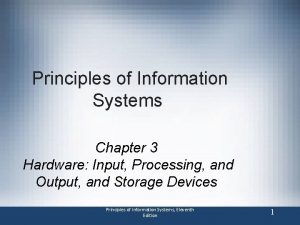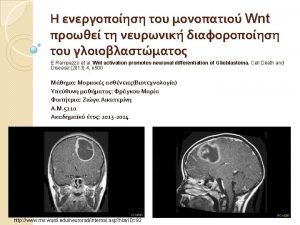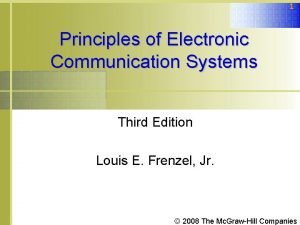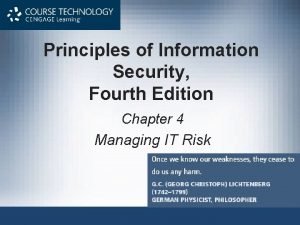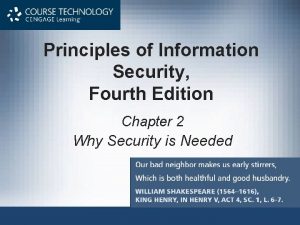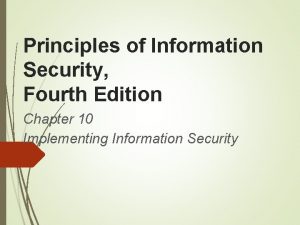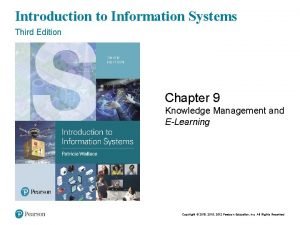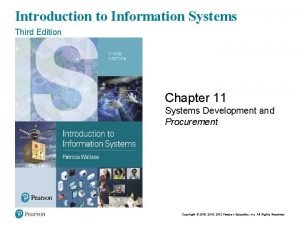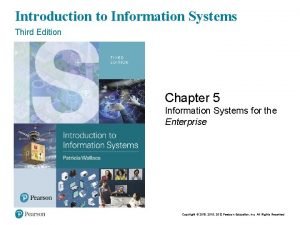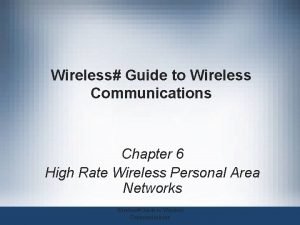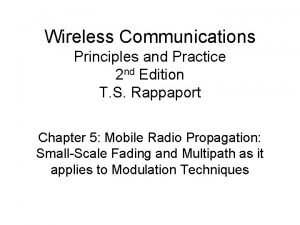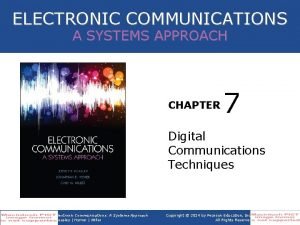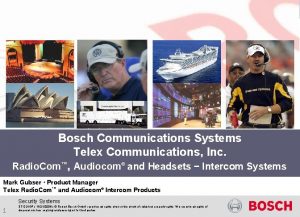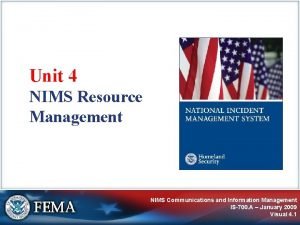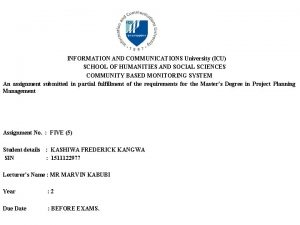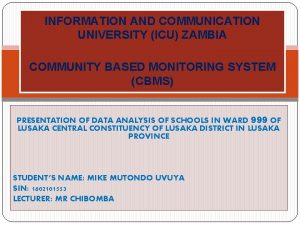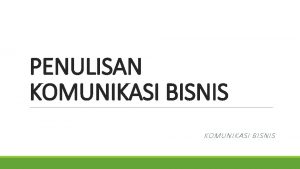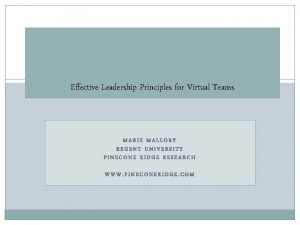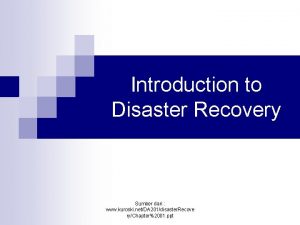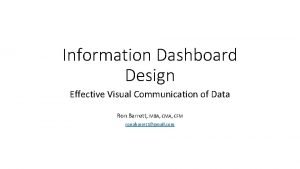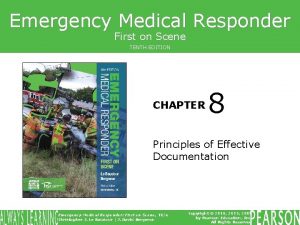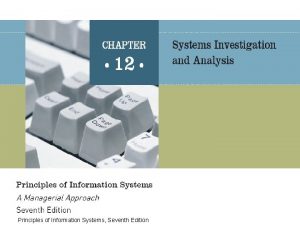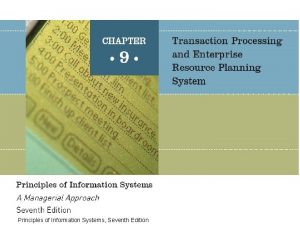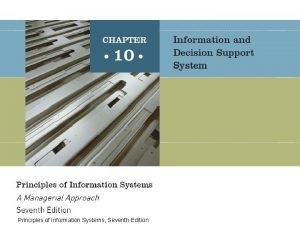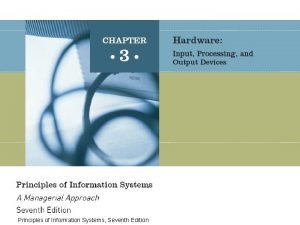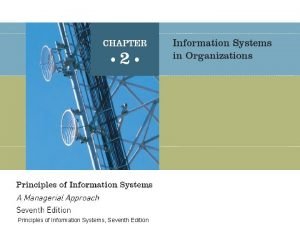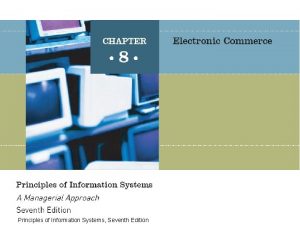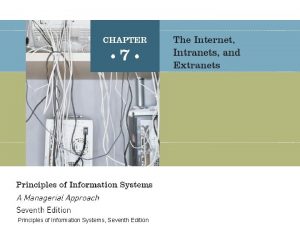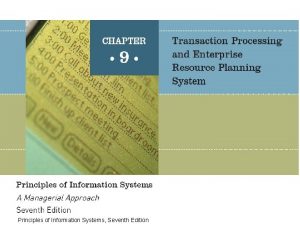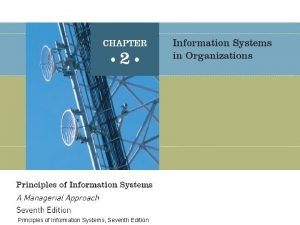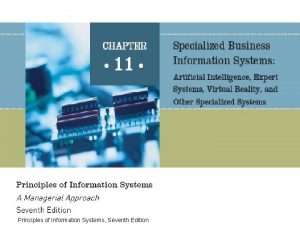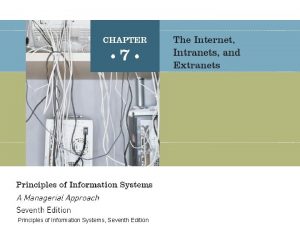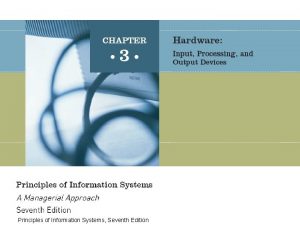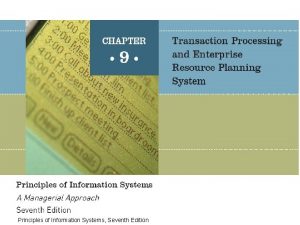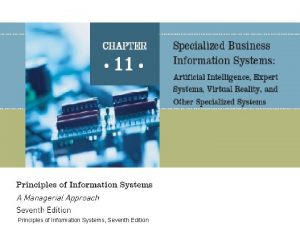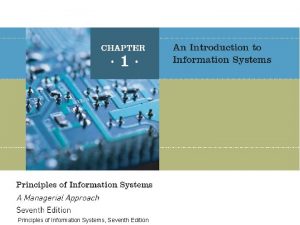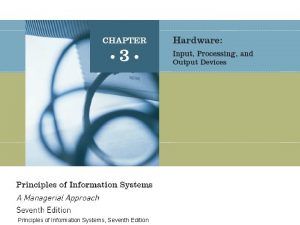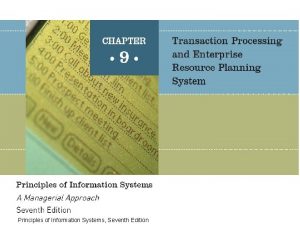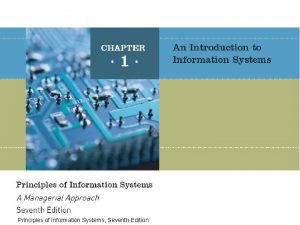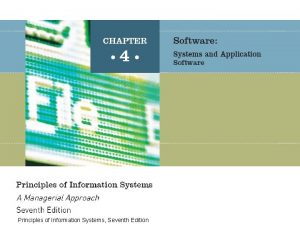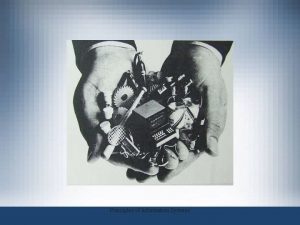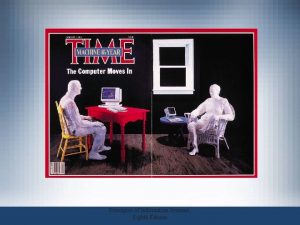Principles of Information Systems Seventh Edition Effective communications

















































- Slides: 49

Principles of Information Systems, Seventh Edition

• Effective communications are essential to organizational success • Define the terms communications and telecommunications and describe the components of a telecommunications system Principles of Information Systems, Seventh Edition 2

• An unmistakable trend of communications technology is that more people are able to send and receive all forms of information over greater distances at a faster rate • Identify broad categories of communications media and discuss the basic characteristics of specific media types • Describe how a modem works • Explain the types of telecommunications carriers today and the services they provide Principles of Information Systems, Seventh Edition 3

• Identify the benefits associated with a telecommunications network • Define the term network topology and identify five alternatives • Discuss the different communications protocols and devices used for telecommunications • Name three distributed processing alternatives and discuss their basic features • List some telecommunications applications that organizations are benefiting from today Principles of Information Systems, Seventh Edition 4

An Overview Of Communications Systems • Communications: the transmission of a signal by way of a medium from a sender to a receiver • Signal contains a message composed of data and information • In telecommunications, sender transmits a signal through a transmission medium such as a cable Principles of Information Systems, Seventh Edition 5

Figure 6. 2: Communications and Telecommunications Principles of Information Systems, Seventh Edition 6

An Overview Of Communications Systems (continued) • Communications can be synchronous or asynchronous • Synchronous communications: the receiver gets the message instantaneously • Asynchronous communications: the receiver gets the message some period of time after it is sent Principles of Information Systems, Seventh Edition 7

Telecommunications • Telecommunications: electronic transmission of signals for communications, via telephone, radio, television, etc. • Data communications: subset of telecommunications that refers to the electronic collection, processing, and distribution of data, typically between computer system hardware devices • Telecommunications medium: anything that carries an electronic signal and interfaces between a sending device and a receiving device Principles of Information Systems, Seventh Edition 8

Figure 6. 3: Elements of a Telecommunications System Principles of Information Systems, Seventh Edition 9

Communications Channels: Basic Communications Channel Characteristics • Communication channels can be classified as simplex, half-duplex, or full-duplex • Simplex channel: can transmit data in only one direction • Half-duplex channel: can transmit data in either direction, but not simultaneously • Full-duplex channel: permits data transmission in both directions at the same time Principles of Information Systems, Seventh Edition 10

Channel Bandwidth and Information. Carrying Capacity • Bandwidth: the range of frequencies that an electronic signal occupies on a given transmission medium • Shannon’s fundamental law of information theory: states that the information-carrying capacity of a channel is directly proportional to its bandwidth • Broadband: telecommunications in which a wide band of frequencies is available to transmit information Principles of Information Systems, Seventh Edition 11

Types of Media • Guided transmission media: communications signals are guided along a solid medium • Wireless media: communications signals are sent over airwaves Principles of Information Systems, Seventh Edition 12

Table 6. 1: Transmission Media Types Principles of Information Systems, Seventh Edition 13

Table 6. 1: Transmission Media Types (continued) Principles of Information Systems, Seventh Edition 14

Modems • A typical telephone line can only accommodate an analog signal (a continuous, curving signal) • A computer generates a digital signal representing bits • Modem: a device that translates data from digital to analog and analog to digital Principles of Information Systems, Seventh Edition 15

Figure 6. 8: How a Modem Works Principles of Information Systems, Seventh Edition 16

Multiplexers • Multiplexers: devices that allow several telecommunications signals to be transmitted over a single communications medium at the same time Principles of Information Systems, Seventh Edition 17

Figure 6. 9: Use of a Multiplexer to Consolidate Data Communications onto a Single Communications Link Principles of Information Systems, Seventh Edition 18

Front-End Processors • Front-end processors: special-purpose computers that manage communications to and from a computer system • Connect a midrange or mainframe computer to hundreds or thousands of communications lines Principles of Information Systems, Seventh Edition 19

Figure 6. 10: Front-End Processor Principles of Information Systems, Seventh Edition 20

Carriers and Services • Local exchange carrier (LEC): a public telephone company in the United States that provides service to homes and businesses within its defined geographical area • Competitive local exchange carrier (CLEC): a company that is allowed to compete with the LECs, such as a wireless, satellite, or cable service provider • Long-distance carrier: a traditional long-distance phone provider, such as AT&T, Sprint, or MCI Principles of Information Systems, Seventh Edition 21

Switched and Dedicated Lines • Switched line: a communications line that uses switching equipment to allow one transmission device to be connected to other transmission devices • Dedicated line: a communications line that provides a constant connection between two points; also called a leased line Principles of Information Systems, Seventh Edition 22

Voice and Data Convergence • Voice over Internet protocol (Vo. IP): the basic transport of voice in the form of a data packet using the Internet protocol • IP telephony is the technology for transmitting voice communications over a network using an open standardsbased Internet protocol • Voice and data convergence: the integration of voice and data applications in a common environment Principles of Information Systems, Seventh Edition 23

WATS • Wide-area telephone service (WATS): a fixed-rate long -distance telecommunications service for heavy users of voice services • IN-WATS service • OUT-WATS service Principles of Information Systems, Seventh Edition 24

ISDN • Integrated services digital network (ISDN): a set of standards for integrating voice and data communications onto a single line via digital transmission over copper wire or other media • ISDN requires special adapters at both ends of the transmission line • ISDN Basic Rate Interface • ISDN Primary Rate Interface Principles of Information Systems, Seventh Edition 25

Figure 6. 12: ISDN Network Switching Principles of Information Systems, Seventh Edition 26

T-Carrier System • Introduced in the 1960 s to support digitized voice transmission • Uses four wires and provides duplex capability • T-1 carrier is capable of carrying 1. 544 Mbps over copper wire; commonly used in U. S. , Japan, and Canada • T-3 line is capable of transmitting data at a rate of 44. 736 Mbps Principles of Information Systems, Seventh Edition 27

Digital Subscriber Line (DSL) • Digital subscriber line (DSL): a telecommunications technology that delivers high-bandwidth information to homes and small businesses over ordinary copper telephone wires • Provides a transmission rate of 512 Kbps to 1. 544 Mbps from the central office to the subscriber • Provides a transmission rate of about 128 Kbps from the subscriber to the central office • Can carry both data and voice signals Principles of Information Systems, Seventh Edition 28

Wireless Mobile Table 6. 3: Some Wireless Data Communications Options Principles of Information Systems, Seventh Edition 29

Networks • Computer network: the communications media, devices, and software needed to connect two or more computer systems and/or devices • Network nodes: the computers and devices on the networks Principles of Information Systems, Seventh Edition 30

Network Types • Personal area network (PAN) • Local area network (LAN) • Metropolitan area network (MAN) • Wide area network (WAN) • International network Principles of Information Systems, Seventh Edition 31

Network Topology • Network topology: logical model that describes how networks are structured or configured Principles of Information Systems, Seventh Edition 32

Figure 6. 15: The Basic Network Topologies Principles of Information Systems, Seventh Edition 33

Terminal-to-Host, File Server, and Client/Server Systems • Classifications based on how computers on the network connect and interoperate • Terminal-to-host: application and database reside on one host computer, and the user interacts with application and data using a “dumb” terminal • File server: the application and database reside on one host computer (file server) • Client/server: multiple computer platforms are dedicated to special functions such as database management, printing, communications, and program execution Principles of Information Systems, Seventh Edition 34

Figure 6. 18: Client/Server Connection Principles of Information Systems, Seventh Edition 35

Interconnecting Networks: Communications Protocols • Open Systems Interconnection (OSI) model • Transmission Control Protocol/Internet Protocol (TCP/IP) • Systems Network Architecture (SNA) • IEEE 802. 3 (Ethernet) Principles of Information Systems, Seventh Edition 36

Communications Protocols (continued) • Frame Relay • Asynchronous Transfer Mode (ATM) • Fire. Wire Principles of Information Systems, Seventh Edition 37

Wireless Communications Protocols • Bluetooth • IEEE 802. 11 b (Wi-Fi) • IEEE 802. 11 g • IEEE 802. 16 (Wi. Max) • IEEE 802. 20 (MBWA) Principles of Information Systems, Seventh Edition 38

Wireless Communications Protocols (continued) • 1 G • 2. 5 G • 3 G • Multichannel Multipoint Distribution System (MMDS) Principles of Information Systems, Seventh Edition 39

Network Switching Devices • Private branch exchange (PBX): an on-premise switching system owned or leased by a private enterprise that interconnects its telephones and provides access to the public telephone system • Bridge: a device used to connect two or more networks that use the same communications protocol • Switch: a telecommunications device that routes incoming data from any one of many ports to a specific output port that will take the data toward its intended destination Principles of Information Systems, Seventh Edition 40

Network Switching Devices (continued) • Router: a device or software in a computer that determines the next network point to which a data packet should be forwarded toward its destination • Hub: a place of convergence where data arrives from one or more directions and is forwarded out in one or more other directions • Gateway: a network point that acts as an entrance to another network Principles of Information Systems, Seventh Edition 41

Network Basics: Basic Processing Strategies • Centralized processing: all processing occurs in a single location or facility • Decentralized processing: processing devices are placed at various remote locations • Distributed processing: computers are placed at remote locations but connected to each other via a network Principles of Information Systems, Seventh Edition 42

Communications Software • Network operating system (NOS): systems software that controls the computer systems and devices on a network and allows them to communicate with each other • Network-management software: enables a manager on a networked desktop to monitor the use of individual computers and shared hardware, scan for viruses, and ensure compliance with software licenses Principles of Information Systems, Seventh Edition 43

Telecommunications Applications • Linking personal computers to mainframes and networks • Voice mail • Electronic software distribution • Electronic document distribution Principles of Information Systems, Seventh Edition 44

Telecommunications Applications (continued) • Call centers • Telecommuting • Videoconferencing • Electronic data interchange (EDI) Principles of Information Systems, Seventh Edition 45

Telecommunications Applications (continued) • Public network services • Electronic funds transfer (EFT) • Distance learning • Specialized systems and services Principles of Information Systems, Seventh Edition 46

Summary • Communications: the transmission of a signal by way of a medium from a sender to a receiver • In telecommunications, the sender transmits a signal through a transmission medium such as a cable • Transmission media types: twisted-pair wire cable, coaxial cable, fiber-optic cable, microwave, cellular, and infrared • Telecommunications carriers can be divided into local exchange carriers, competitive local exchange carriers, and long-distance carriers Principles of Information Systems, Seventh Edition 47

Summary (continued) • A computer network consists of the communications media, devices, and software needed to connect two or more computer systems and/or devices • Network types: personal area network (PAN), local area network (LAN), metropolitan area network (MAN), wide area network (WAN), and international network • Network topologies: ring, bus, hierarchical, star, and hybrid • Options for how computers on a network connect: terminal-to-host, file server, and client/server Principles of Information Systems, Seventh Edition 48

Summary (continued) • Communications protocols include the Open Systems Interconnection (OSI) model, Transmission Control Protocol/Internet Protocol (TCP/IP), IEEE 802. 3 (Ethernet), etc. • Network switching devices: private branch exchange (PBX), bridge, switch, router, hub, and gateway • Examples of telecommunications applications are voice mail, electronic software distribution, telecommuting, videoconferencing, electronic funds transfer, and distance learning Principles of Information Systems, Seventh Edition 49
 Information management principles
Information management principles Principles of information systems 11th edition
Principles of information systems 11th edition Endomysium
Endomysium Database system concepts seventh edition
Database system concepts seventh edition Molecular biology of the cell seventh edition
Molecular biology of the cell seventh edition Biology seventh edition
Biology seventh edition Principles of electronic communication systems 3rd edition
Principles of electronic communication systems 3rd edition Principles of electronic communication systems 3rd edition
Principles of electronic communication systems 3rd edition Expert systems: principles and programming, fourth edition
Expert systems: principles and programming, fourth edition Principles of information security 5th edition pdf
Principles of information security 5th edition pdf Concentration risk
Concentration risk Principles of information security 4th edition
Principles of information security 4th edition Principles of information security 4th edition
Principles of information security 4th edition Introduction to information systems 6th edition
Introduction to information systems 6th edition Fundamentals of information systems 9th edition
Fundamentals of information systems 9th edition Fundamentals of information systems 9th edition
Fundamentals of information systems 9th edition Fundamentals of information systems chapter 1
Fundamentals of information systems chapter 1 Management information systems 16th edition
Management information systems 16th edition Introduction to information systems 3rd edition
Introduction to information systems 3rd edition Introduction to information systems 5th edition
Introduction to information systems 5th edition Fundamentals of information systems 9th edition
Fundamentals of information systems 9th edition Voyage estimating decision support system
Voyage estimating decision support system Introduction to information systems 3rd edition
Introduction to information systems 3rd edition Fundamentals of information systems 9th edition
Fundamentals of information systems 9th edition Introduction to information systems 3rd edition
Introduction to information systems 3rd edition Steps in developing effective communications
Steps in developing effective communications Data and computer communications 10th edition
Data and computer communications 10th edition Guide to wireless communications 4th edition
Guide to wireless communications 4th edition Principles of complex systems for systems engineering
Principles of complex systems for systems engineering Mis chapter 6
Mis chapter 6 Using mis (10th edition) 10th edition
Using mis (10th edition) 10th edition Sircim
Sircim Electronic communications a systems approach
Electronic communications a systems approach Bosch communication systems
Bosch communication systems Nims communications and information management
Nims communications and information management Information and communications university
Information and communications university Icu zambia
Icu zambia Principles of teamwork
Principles of teamwork Steve blom
Steve blom Principles of effective practice
Principles of effective practice Writing business communication
Writing business communication Principles of effective leadership in virtual teams
Principles of effective leadership in virtual teams Principles of effective writing
Principles of effective writing Principles of effective intervention
Principles of effective intervention 11 principles of effective character education
11 principles of effective character education Principles of effective planning
Principles of effective planning Information dashboard design
Information dashboard design Chapter 8 principles of effective documentation
Chapter 8 principles of effective documentation 10 principles of effective online teaching
10 principles of effective online teaching Basic principles of effective portfolio management
Basic principles of effective portfolio management

